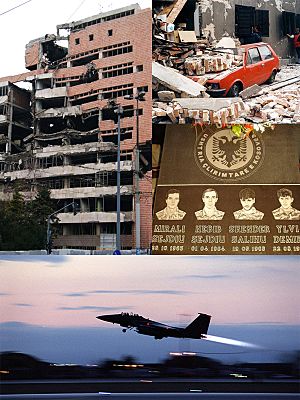Kosovo War facts for kids
The Kosovo War was a serious conflict that happened in the country of Yugoslavia from 1998 to 1999. It was part of the larger Yugoslav Wars. The main groups fighting were the Kosovo Liberation Army (KLA) and the Yugoslavian army. In 1999, NATO (a group of countries working together for safety) started bombing Yugoslavia. They did this to try and stop violence against people in Kosovo.
Quick facts for kids Kosovo War |
|||||||||
|---|---|---|---|---|---|---|---|---|---|
| Part of the Yugoslav Wars | |||||||||
 Clockwise from top-left: Yugoslav general staff headquarters damaged by NATO air strikes; a Zastava Koral buried under rubble caused by NATO air strikes; memorial to local KLA commanders; a USAF F-15E taking off from Aviano Air Base |
|||||||||
|
|||||||||
| Belligerents | |||||||||
|
|
|||||||||
| Commanders and leaders | |||||||||
|
|
|
||||||||
| Strength | |||||||||
|
(Operation Eagle Eye) (Operation Allied Force) |
|
||||||||
| Casualties and losses | |||||||||
|
|
Caused by KLA: |
||||||||
|
|
|||||||||
What Caused the War?
The Kosovo War began because of a long history of disagreements in the region. Kosovo was a part of Serbia, which was then part of Yugoslavia. Most people living in Kosovo were ethnic Albanians, but there was also a large Serb population.
Rising Tensions
In the 1990s, tensions grew. Many Albanians in Kosovo wanted to be independent from Serbia. The Kosovo Liberation Army (KLA) was formed. It was a group that fought for Kosovo's independence. The government of Yugoslavia, led by Slobodan Milošević, wanted Kosovo to remain part of Serbia.
Fighting Begins
Fighting started in 1998 between the KLA and the Yugoslav army and police. There were many reports of violence against civilians. This made the international community worried.
NATO's Involvement
As the conflict continued, many countries became concerned about the violence. They worried about the safety of the people in Kosovo.
Diplomatic Efforts
Leaders from different countries tried to find a peaceful solution. They held talks, like the Rambouillet talks in France. However, these talks did not lead to an agreement.
Air Strikes Begin
Because no peaceful solution was found, NATO decided to act. In March 1999, NATO started an air bombing campaign against Yugoslavia. This was called Operation Allied Force. NATO's goal was to stop the violence and protect the people in Kosovo.
The Air Campaign
NATO's air strikes targeted military sites and other important locations in Yugoslavia. The bombing lasted for 78 days. It was a very controversial decision, meaning people had strong opinions about whether it was the right thing to do.
End of the War
The war ended in June 1999. A peace agreement was signed.
Kumanovo Treaty
The agreement, known as the Kumanovo Treaty, said that Yugoslav forces had to leave Kosovo. After this, NATO forces entered Kosovo to help keep the peace.
United Nations Resolution
The United Nations also passed a resolution. This resolution placed Kosovo under temporary UN administration. This meant the UN would help govern Kosovo for a while.
Aftermath of the Conflict
- Many Albanian refugees who had fled during the war were able to return home.
- Sadly, many Serb and other non-Albanian civilians also left Kosovo after the war.
- The war changed Kosovo's future. While it officially remained part of Yugoslavia (later Serbia and Montenegro), it was managed by the UN. Kosovo later declared its independence in 2008.
Related pages
Images for kids
-
Royal Canadian Mounted Police (RCMP) officers investigate an alleged mass grave, alongside US Marines
-
Refugee camp in Fier, Albania
See also
 In Spanish: Guerra de Kosovo para niños
In Spanish: Guerra de Kosovo para niños










